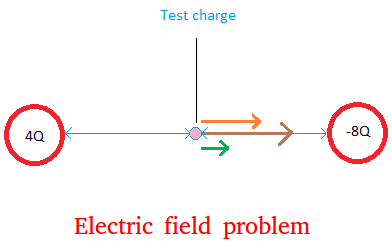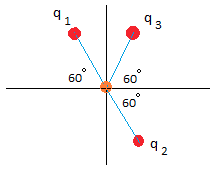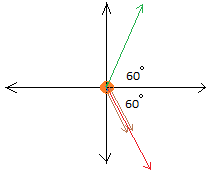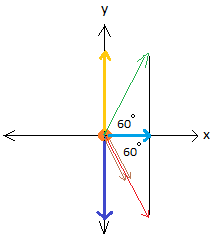Electric field problems
The following electric field problems will help you sharpen your knowledge of electric field. Things that you absolutely need in order to solve the problems on this lesson.
- Know how to use the formula below:
- Know how to draw the electric field vector.
- Know how do solve math problems that have multiplication and division of exponents.
- Use k = 9 × 109 N.m2/C2
- Convert d to meter before doing the math.
- The electric field unit is N/C
Problem #1
A particle with charge q = 5Q is placed at a distance d from a point A.
1. Calculate the electric field produced at the point A in terms of k, Q and d.
2. Calculate the electric field produced at the point A if Q = 10-10 and d = 3 cm.Solution
When solving electric field problems, you need to find the magnitude and the direction of the electric field. You cannot just look for one and forget about the other.
To find the magnitude, use the formula shown above.
To find the direction, put a small positive test charge in the field and then find out if it will be attracted or repulsed.
For this problem it is very easy to find the magnitude of the electric field. Just substitute 5Q for q. The next two electric field problems will take things to the next level.
1.2.
d = 3 × 10-2
d2 = 9 × 10-4
E = 5 × 103 N/C
Put the test charge at point A. The direction of the electric field is shown below.

More challenging electric field problems
Caution
Take your time when reading the following electric field problems. Do not rush it!
Two particles with charges q1 = 4Q and q2 = -8Q are placed at the same distance d from a point A. Charges q1 and q2 and point A are all on the same line. Calculate the electric field produced at the point A in terms of k, Q and d.
Let E1 be the electric field for q1
Let E2 be the electric field for q2
Net electric field = E = E1 + E2
Since the denominator is the same, we can just add 4Q and 8Q.
4Q + 8Q = 12Q
Put the test charge at point A. The direction of the electric field is shown below with the brown arrow.
Notice how the brown vector is the result of adding the green vector and the orange vector.
Notice also how the size of the orange vector is twice that of the green since 8Q is twice 4Q.

Problem #3
Three particles with charges q1 = 2Q, q2 = -2Q, and q3 = 4Q are placed at the same distance d from a test charge placed at the origin. Charges q1 , q2, and q3 and point A are arranged as you see below. Calculate the electric field produced at the point A in terms of k, Q and d.

q2 is negative, so the orange test charge is attracted to q2. We show this with the second brown arrow.

|
E1 = k
2Q
d2
|
E1 = k
2Q
d2
|
Let E3 be the electric field for q3 (Shown with green arrow)
We need to find the net electric charge for E3 (Green arrow) and E1 and E3 (Red arrow)

We need to add all the x components and all the y components for the two vectors (green and red).
When looking at the graph, I see that the y components are shown in gold and dark blue. Moreover, I immediately see that the y components add up to zero.
For both the green and the red vector, the x components is the blue line.
Find the x component of the green vector
Line in blue = line in green × cos(60°)
Line in blue = line in green × 0.5
To Find the x component of the red vector, we basically repeat what we
did for the green vector to end up with the exact same answer.
Perhaps the last two electric field problems were hard. Send your questions.